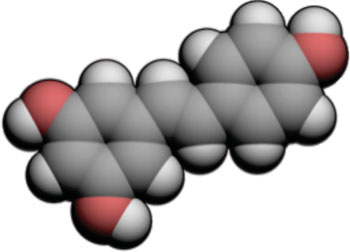Low Doses of Resveratrol Activate Stress-lowering Molecular Pathway
By LabMedica International staff writers
Posted on 05 Jan 2015
A molecular mechanism has been identified that explains how the wine and grape product resveratrol modulates the inflammatory response by interacting with the enzyme tyrosyl transfer-RNA (tRNA) synthetase (TyrRS).Posted on 05 Jan 2015
Resveratrol (trans-3,5,4'-trihydroxystilbene), a compound found largely in the skins of red grapes, is a component of Ko-jo-kon, a form of oriental medicine used to treat diseases of the blood vessels, heart, and liver. Red wine contains between 0.2 and 5.8 milligrams per liter of resveratrol, depending on the grape variety, while white wine has much less, the reason being that red wine is fermented with the skins, allowing the wine to absorb the resveratrol, whereas white wine is fermented after the skin has been removed. Resveratrol came to scientific attention during the mid-1990s as a possible explanation for the "French Paradox,” the low incidence of heart disease among the French, who eat a relatively high-fat diet. Since then, it has been promoted by manufacturers and examined by scientific researchers as an antioxidant, an anticancer agent, and a phytoestrogen.

Image: Three-dimensional molecular space-fill model of resveratrol (Photo courtesy of Wikimedia Commons).
Investigators at The Scripps Research Institute (La Jolla, CA, USA) had been studying TyrRS, which moves into the nucleus under stress conditions. In light of the stress-related benefits of resveratrol, they considered the possibility that the tyrosine-like phenolic ring of resveratrol might fit into the active site pocket of TyrRS to induce the enzyme's nuclear role.
To examine this possibility they used X-ray crystallography to generate a 2.1 Angstrom co-crystal structure of resveratrol bound to the active site of TyrRS. The results, which were published in the December 22, 2014, online edition of the journal Nature, revealed that resveratrol nullified the catalytic activity of the enzyme and redirected it to a nuclear function. In the nucleus the enzyme stimulated NAD+-dependent auto-poly-ADP-ribosylation of poly(ADP-ribose) polymerase 1 (PARP-1). PARP-1 is a major stress response and DNA-repair factor that is thought to have a significance influence on lifespan.
The TyrRS/resveratrol interaction was confirmed in a mouse model. Injection of resveratrol led to activation of PARP-1 by TyrRS with subsequent activation of several protective genes including the tumor-suppressor gene p53 and the longevity genes FOXO3A and SIRT6. PARP-1 activation could be specifically blocked in vivo by a resveratrol-displacing tyrosyl adenylate analogue.
The results indicated that the TyrRS-PARP-1 pathway could be measurably activated by much lower doses of resveratrol - as much as 1,000 times lower -than had been used in some prior studies, including those focused on SIRT1.
“This stress response represents a layer of biology that has been largely overlooked, and resveratrol turns out to activate it at much lower concentrations than those used in prior studies,” said senior author Dr. Paul Schimmel, professor of chemical biology at The Scripps Research Institute. “We think this is just the tip of the iceberg. We think there are a lot more amino-acid mimics out there that can have beneficial effects like this in people. And we are working on that now.”
Related Links:
The Scripps Research Institute













